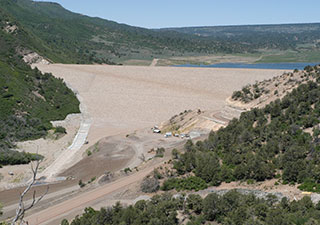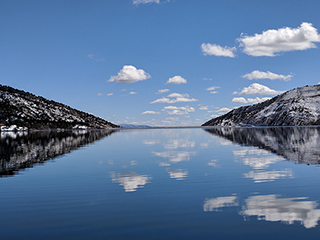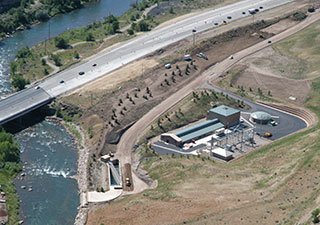- Reclamation
- Upper Colorado Basin
- Programs & Activities
- Animas-La Plata Project
Animas-La Plata Project

The Animas-La Plata Project located in La Plata and Montezuma Counties in southwestern Colorado and in San Juan County in northwestern New Mexico, was authorized by the Colorado River Basin Project Act of September 30, 1968 (Public Law 84-485). In 1988, it was incorporated into the Colorado Ute Indian Water Rights Settlement Act. The Colorado Ute Settlement Act Amendments of 2000 provide for implementation and completion of the project. Approval to begin construction was granted in October 2001 and initial site work began in April 2002.
Lake Nighthorse began filling on May 4, 2009, and filled for the first time on June 29, 2011. The maximum water surface elevation of 6,882 feet equates to 123,541 acre-feet in storage. The Colorado project features were transferred from construction status to operation and maintenance status in March 2013. Work on completion of the transfer stipulations is continuing. An operation and maintenance contract has been signed with the Animas-La Plata Operations, Maintenance and Replacement Association that allows project sponsors to operate Colorado project features.
This is the new HydroData portal for Lake Nighthorse this new web-based data interface tool will update current and historical reservoir operations. To view the HydroData portal full screen click here.
Lake Nighthorse Recreation

The Lake Nighthorse Recreation Area is now open. The recreation area is managed by the City of Durango, to learn more about the recreation opportunities available at Lake Nighthorse visit durangogov.org/LakeNighthorse.
To protect cultural resources in the area, recreation is only allowed in developed areas and 25 feet above the high-water level around the reservoir. Land around Lake Nighthorse that is off limits to recreation have been posted with no trespass signs and all visitors receive a brochure with rules for recreating at the lake. Destruction or removal of cultural resources will be prosecuted.
- Ridges Basin Cultural Resource Management Plan- May 2017
- Final EA for Lake Nighthorse Recreation Plan - December 19, 2016
- Comments on Lake Nighthorse Recreation Plan - December 19, 2016
- News Release - Reclamation Releases the Final Environmental Assessment for Lake Nighthorse Recreation Plan
- News Release - Work Begins on Lake Nighthorse Boat Inspection and Decontamination Station
- News Release - Extended Draft EA Comment Period for Lake Nighthorse Recreation Plan
- News Release - Draft EA for the Lake Nighthorse Recreation Plan
- News Release - Public Meeting on Recreation - June 18, 2014
Project Information
| Structural Height | 270 feet |
|---|---|
| Crest Length | 1,640 feet |
| Releases | 110 cfs with periodic peaks up to 200 cfs |
| Active Storage Capacity | 90,000 acre-feet |
|---|---|
| Inactive Storage Capacity | 30,000 acre-feet |
| Total Storage Capacity | 120,000 acre-feet |
| Total Water Surface | 1,490 acres |
| Maximum Dynamic Lift | 550 feet |
|---|---|
| Capacity | 280 cubic feet per second |
| Length | 2.1 miles |
|---|---|
| Capacity | 280 cubic feet per second |
| Length | 30 miles approx. |
|---|---|
| Initial Capacity | 12.9 cubic feet per second |
Background / History

The Animas-La Plata Project, located in southwestern Colorado and northwestern New Mexico, has been the subject of substantial public interest and environmental review since it was authorized. Following is a short history leading to the initiation of project construction, and current construction progress.
1968 - United States Congress authorized construction of the A-LP Project
1980 - The Bureau of Reclamation released a Final Environmental Statement on the project.
1988 - Congress passed the Colorado Ute Indian Water Rights Settlement Act which authorized the implementation of a 1986 water rights settlement agreement.
1990 - Based on new biological information, the U.S. Fish and Wildlife Service issued a draft biological opinion concluding that the project would jeopardize the continued existence of the Colorado pikeminnow.
1991 - The Service issued a Final Biological Opinion containing a reasonable and prudent alternative that limited the project depletions to 57,100 acre-feet per year. This opinion allowed construction of the project to begin.
1992- A lawsuit filed by environmental organizations halted construction of the project.
1996 - Reclamation released a Final Supplement to the Final Environmental Statement, that addressed updated environmental information.
1996-97 - Supporters and opponents of the project addressed unresolved issues associated with the original A-LP Project to gain consensus on an alternative to the project. (Romer/Schoettler Process)
1998 - The Department of the Interior recommended construction of a substantially scaled-down project that was designed to satisfy the intent of Colorado Ute Tribes' 1986 water rights settlement agreement.
2000 - Reclamation released a Final Supplemental Environmental Impact Statement and Record of Decision that identified the selected alternative as a down-sized project that focused on providing the Colorado Ute Tribes, as well as others, an assured water supply. Congress authorized construction of the scaled-down project with the Colorado Ute SettlementActAmendments of 2000.
2001 - November 9, 2001, Reclamation Commissioner grants approval to initiate project construction.
2002 - Construction began with installation of the Inlet Conduit Sleeve.
2003 - Update of Project Construction Cost Estimate reveals increase of project cost from approximately $338 million to $500 million. Ridges Basin Dam Outlet Works excavation was completed. Durango Pumping Plant excavation was initiated.
2004 - Construction continued on Ridges Basin Dam foundation excavation with over two million cubic yards of material excavated. DPP excavation, Intake Structure, and fish bypass were substantially completed. Preliminary design for the Navajo Nation Municipal Pipeline continued.
2005 - Construction was initiated on the DPP structure. Erection of an onsite Sky Ute Sand and Gravel concrete batch plant at the DPP site was completed and brought into production. The main pumping plant bay foundation and first floor concrete were completed. The floor of the intake channel/fish screen was completed. The pipes to and from the pumps were installed and were encased in concrete. Ridges Basin Dam Completion Contract was awarded in March. Foundation grouting on the foundation and both abutments was initiated. Placement of the zone materials (including sand and filter drains, impervious clay core, and Zone 4 shell) continued. The materials processing plant was erected and produced Zone 2 (sand), Zone 3 (gravel), Zone 6 (rock), and road base materials. On August 12, 2005, the Ridges Basin Dam Zone One Clay Placement Ceremony was held. During the ceremony, religious leaders of the Colorado Ute Indian Tribes blessed the building of the dam. The outlet works tunnel and gate chamber was excavated and concrete invert tunnel lining was initiated. Construction of Basin Creek Drop Structures was initiated.
2006 - Construction continued on the DPPApproximately 20,000 cubic yards of concrete were placed through the end of 2006 at the intake fish screen, plant, and air chamber structures. Installation, at the pumping plant site, of a portion of the 72-inch buried steel pipeline (Ridges Basin Inlet Conduit) was initiated and completed. Ridges Basin Dam construction continued. Approximately three million cubic yards of embankment zoned fill material were placed bringing the dam elevation to an average height of 6,783 feet. Grouting operations continued through this season on the dam abutments and in the outlet works tunnel. The materials processing plant continued in full production until winter shutdown. The outlet works tunnel upstream reinforced concrete lining and down stream arch lining were completed. Concrete lining in the gate chamber was initiated in late fall. The intake tower was completed to elevation 6,760 feet. Construction of Basin Creek Drop Structures were completed.
2007 - Construction on the DPP is 78 percent complete. The DPP structure was completed using a total of 21,300 cubic yards of concrete and the roof was installed. The fish screen was installed in the intake structure and the air chamber for the 72-inch inlet conduit was completed. Ridges Basin Dam was topped out at an elevation of 6,893 feet. At the outlet works the gate chamber was completed and a 4 x 6 foot slide gate was installed. A 66-inch steel outlet pipe was installed in the downstream arch tunnel and the access walkways were completed. Construction of the control house started and a 60-inch jet flow and sleeve valve gate was installed.
2008 - General construction of Ridges Basin Dam and Inlet Conduit, Durango Pumping Plant, and appurtenant structures of the Animas-La Plata Project were completed. In September 2008, the first two major contracts were awarded for work on the Navajo Nation Municipal Pipeline marking the start of construction on the fourth major component of the project.
2009 - The first fill of Lake Nighthorse commenced May 4, 2009. Significant progress was made on construction of the Navajo Nation Municipal Pipeline portion of the project by the Navajo Engineering and Construction Authority.
2010 - Construction continued on the Navajo nation Municipal Pipeline and the permanent operating facility for the project. First fill of the reservoir continued reaching 50 percent of capacity when pumping ended in June. The project sponsors formed the Animas-La Plata Operations, Maintenance and Replacement Association to assume operational responsibility for the Colorado project jeatures.
2011 - Lake Nighthorse filled the first time on June 29, 2011, with 123,541 acre-feet of water storage. In May, a three-week flow test of the Basin Creek Improvements was conducted to test the series of channel improvements and small check dams, or drop structures to convey water released from Ridges Basin Dam down Basin Creek to the Animas River without increasing, or decreasing, the sediment transport to the river.
2012 - The Bureau of Reclamation, Animas-La Plata Water Conservancy District, and community of Durango developed a Recreation Master Plan for Lake Nighthorse and completed the National Environmental Policy Act compliance review. The area in and around Lake Nighthorse would not beopened for public use until a recreation management entity could beidentified and appropriate recreation facilities constructed. Pipe laying operations on the Navajo Nation Municipal Pipeline were completed in July.
2013 - The Colorado project features were transferred from construction status to operation and maintenance status in March 2013. Work continued on connections to existing distribution systems.
Environmental Compliance
- La Plata West Water Authority Raw Water Project Final Environmental Assessment | FONSI (August 2016)
- Animas-La Plata Project Environmental Commitment Checklist - 2009 Update (May 2010)
- Animas River Fisheries Database Synthesis and Analysis Final Report (July 2008)
- Vegetation and Wildlife Mitigation Final Report (April 2008)
- Animas River Fish Passage and Canal Entrainment Evaluation and Recommendations (April 2007)
- Record of Decision - Animas-La Plata Project/Colorado Ute Indian Water Rights Settlement Final Supplemental EIS
Contracts & Agreements
- Draft Repayment Contract - Between the United States and the Southern Ute Indian Tribe, Animas-La Plata Project
- Draft Operations Agreement - Between the United States, the Navajo Nation, and the City of Farmington, N.M., Animas-La Plata Project Navajo Nation Municipal Pipeline
- Final Repayment Contract - Between the United States and the state of Colorado, Department of Natural Resources Colorado Water Conservation Board
- Intergovernmental Agreement - Establishing the Animas-La Plata Operation, Maintenance, and Replacement Association
- Final Operation, Maintenance, and Replacement Contract - Animas-La Plata Project
- Final Repayment Contract Between the United States and La Plata Conservancy District, New Mexico
- Final Amended and Restated Agreement in Principle Concerning the Colorado Ute Indian Water Rights Settlement And Binding Agreement For Animas-La Plata Cost Sharing
- Final Funding Agreement and Repayment Contract Between the United States and the Colorado Water Resources and Power Development Authority
- Final Amendment and Restated Escrow Agreement With the Colorado Water Resources and Power Development Authority
- Final Amended and Restated Agreement and Instructions for Administering Above Escrow Agreement with the Colorado Water Resources and Power Development Authority
- Final Amendatory Funding Agreement and Repayment Contract Between the United States and the San Juan Water Commission
- Final Escrow Agreement with The San Juan Water Commission
- Final Agreement and Instructions for Administering Escrow Account Between the United States Department of the Interior and the San Juan Water Commission
- Environmental Commitments - Exhibit A: San Juan Water Commission Amendatory Funding Agreement and Repayment Contract; Exhibit A: La Plata Conservancy District Repayment Contract; Exhibit A: Animas-La Plata Project Operation, Maintenance, and Replacement Contract; Exhibit B: Colorado Water Resources and Power Development Authority Funding Agreement and Repayment Contract
